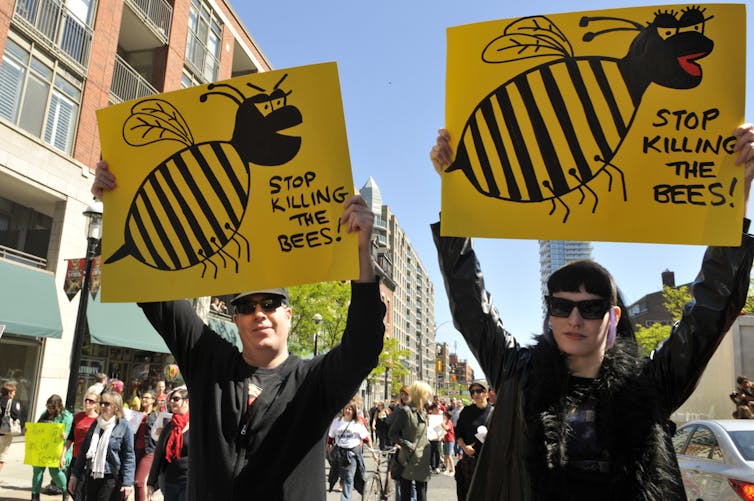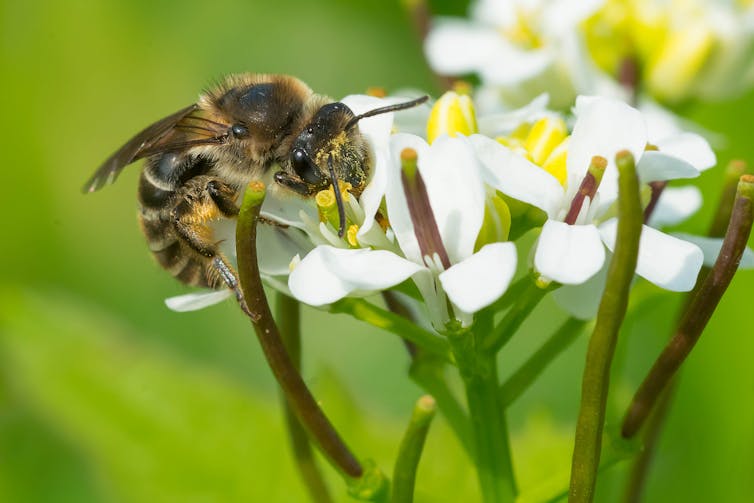Porto Alegre (Brazil) (AFP) – Humanitarian aid arrived Tuesday in Porto Alegre and other flood-ravaged municipalities of southern Brazil, where queues formed for drinking water as forecasters warned of more downpours.
Issued on: 07/05/2024 -

Nearly 400 municipalities have been hit by devastating floods in southern Brazil, and more than 156,000 people have been forced to leave their homes
© Nelson ALMEIDA / AFP
The worst natural calamity ever to hit the state of Rio Grande do Sul has claimed at least 90 lives, with 362 people reported injured and 131 still missing, according to the civil defense force that handles disaster relief.
Nearly 400 municipalities in total have been hit, including state capital Porto Alegre, and more than 156,000 people have been forced to leave their homes as streets were transformed into rivers after days of rain in unprecedented amounts.
Porto Alegre is home to some 1.4 million people and the larger metropolitan area more than double that.
For tens of thousands of people left stranded amid impassable roads, collapsed bridges and flooded homes in Rio Grande do Sul, "the most urgent demand is (drinking) water," said civil defense official Sabrina Ribas.
Helicopters were flying two and fro delivering water and food to communities most in need, while work continued on restoring road access.
In the municipality of Alvorada, west of Porto Alegre, there were queues of people with buckets and plastic bottles, collecting drinking water from the few municipal taps still working.
Most shops have run out of bottled water.
"This is horrible. We have children," said 27-year-old Gabriela Almeida, queuing at a public tap with a one-year-old in her arms.
The worst natural calamity ever to hit the state of Rio Grande do Sul has claimed at least 90 lives, with 362 people reported injured and 131 still missing, according to the civil defense force that handles disaster relief.
Nearly 400 municipalities in total have been hit, including state capital Porto Alegre, and more than 156,000 people have been forced to leave their homes as streets were transformed into rivers after days of rain in unprecedented amounts.
Porto Alegre is home to some 1.4 million people and the larger metropolitan area more than double that.
For tens of thousands of people left stranded amid impassable roads, collapsed bridges and flooded homes in Rio Grande do Sul, "the most urgent demand is (drinking) water," said civil defense official Sabrina Ribas.
Helicopters were flying two and fro delivering water and food to communities most in need, while work continued on restoring road access.
In the municipality of Alvorada, west of Porto Alegre, there were queues of people with buckets and plastic bottles, collecting drinking water from the few municipal taps still working.
Most shops have run out of bottled water.
"This is horrible. We have children," said 27-year-old Gabriela Almeida, queuing at a public tap with a one-year-old in her arms.

For tens of thousands of people left stranded amid impassable roads, collapsed bridges and flooded homes, 'the most urgent need is (drinking) water,' said civil defense official Sabrina Ribas © NELSON ALMEIDA / AFP
Individuals and businesses with wells were doing what they could to help.
Alvorada resident Benildo Carvalho, 48, was one of them -- filling neighbors' bottles with a hose as a line of people started to form outside his house.
"It's a matter of solidarity," he told AFP. "You cannot deny people water."
Only one of Porto Alegre's six water treatment plants was functioning, the mayor's office said, and hospitals and shelters were being supplied by tankers.
'Changed the map'
President Luiz Inacio Lula de Silva said more emergency funds would be freed up Tuesday, vowing there would be "no lack of resources to meet the needs of Rio Grande do Sul."
Some 15,000 soldiers, firefighters, police and volunteers were hard at work in planes and boats, even jet skis, to rescue those who are trapped and bring aid where they can.
Brazil's neighbors Uruguay and Argentina have sent rescue equipment and trained personnel.
Individuals and businesses with wells were doing what they could to help.
Alvorada resident Benildo Carvalho, 48, was one of them -- filling neighbors' bottles with a hose as a line of people started to form outside his house.
"It's a matter of solidarity," he told AFP. "You cannot deny people water."
Only one of Porto Alegre's six water treatment plants was functioning, the mayor's office said, and hospitals and shelters were being supplied by tankers.
'Changed the map'
President Luiz Inacio Lula de Silva said more emergency funds would be freed up Tuesday, vowing there would be "no lack of resources to meet the needs of Rio Grande do Sul."
Some 15,000 soldiers, firefighters, police and volunteers were hard at work in planes and boats, even jet skis, to rescue those who are trapped and bring aid where they can.
Brazil's neighbors Uruguay and Argentina have sent rescue equipment and trained personnel.

The Beira-Rio stadium of Porto Alegre's Internacional football team has been flooded
© Anselmo Cunha / AFP
As the calamity showed no signs of abating, weather forecasts suggested it could still get worse.
The Inmet meteorological institute warned of possible storms in the south of Rio Grande do Sul until Wednesday, followed by rainfall in the center and north it said would imperil the rescue effort.
The state's Guaiba River, which runs through Porto Alegre, remained at historic levels Tuesday.
According to weather agency MetSul, the flooding has "changed the map of the metropolitan region" of Porto Alegre.
Police, meanwhile, said there have been reports of evacuated homes being looted and some residents, afraid of such intrusions, were refusing to move to shelters.
© 2024 AFP
As the calamity showed no signs of abating, weather forecasts suggested it could still get worse.
The Inmet meteorological institute warned of possible storms in the south of Rio Grande do Sul until Wednesday, followed by rainfall in the center and north it said would imperil the rescue effort.
The state's Guaiba River, which runs through Porto Alegre, remained at historic levels Tuesday.
According to weather agency MetSul, the flooding has "changed the map of the metropolitan region" of Porto Alegre.
Police, meanwhile, said there have been reports of evacuated homes being looted and some residents, afraid of such intrusions, were refusing to move to shelters.
© 2024 AFP
Brazil's football giants rally to help victims of deadly flooding
Rio de Janeiro (AFP) – Brazil's football giants -- including Neymar, Vinicius Junior and Ronaldinho -- are rallying behind a fundraising effort for victims of devastating floods that have killed at least 85 people in the south of the country.
Issued on: 07/05/2024 -

Rio de Janeiro (AFP) – Brazil's football giants -- including Neymar, Vinicius Junior and Ronaldinho -- are rallying behind a fundraising effort for victims of devastating floods that have killed at least 85 people in the south of the country.
Issued on: 07/05/2024 -

Aerial view of the flooded Arena do Gremio Stadium, of Brazilian football team Gremio, in Porto Alegre on May 7, 2024
© CARLOS FABAL / AFP
Using their huge social media presence, the stars of Brazil's most popular sport have joined ranks with local club players, who have used their own jet skis to help people escape waters that have completely inundated entire towns.
Former Barcelona and Paris Saint-Germain forward Neymar, 32, shared a video Tuesday showing his private jet being filled with crates of water bottles and other supplies.
"Brazil is going through a delicate moment and helping is NEVER too much," he wrote in the post shared with his 221 million followers, after endorsing a call for donations led by the Brazilian Football Confederation.
Brazil's southern state of Rio Grande do Sul was hit by deadly flooding last week after days of heavy rains, forcing more than 150,000 people from their homes and cutting off many from drinking water and electricity.
The disaster, which the government and experts have linked to climate change, swept away bridges and roads, further complicating humanitarian relief.
Floodwater also filled the stadiums and training facilities of Porto Alegre's two main football clubs, Internacional and Gremio. The typically fierce rivals have united in rescue efforts.
"We are all on the same side. This is our goal," Uruguayan goalkeeper Sergio Rochet, who plays for Internacional, told local station Radio Gaucha.
He and Ecuadoran teammate Enner Valencia have personally delivered aid supplies to a shelter for displaced people.
Opposing Brazilian goalkeeper Caique, of Gremio, also took dramatic measures to help -- using his jet ski to save people in Porto Alegre cut off by the overflowing Guaiba River.
His teammate Diego Costa, a Brazilian-born forward, donated four jet skis to help rescue people stranded by floodwaters.
© 2024 AFP
Using their huge social media presence, the stars of Brazil's most popular sport have joined ranks with local club players, who have used their own jet skis to help people escape waters that have completely inundated entire towns.
Former Barcelona and Paris Saint-Germain forward Neymar, 32, shared a video Tuesday showing his private jet being filled with crates of water bottles and other supplies.
"Brazil is going through a delicate moment and helping is NEVER too much," he wrote in the post shared with his 221 million followers, after endorsing a call for donations led by the Brazilian Football Confederation.
Brazil's southern state of Rio Grande do Sul was hit by deadly flooding last week after days of heavy rains, forcing more than 150,000 people from their homes and cutting off many from drinking water and electricity.
The disaster, which the government and experts have linked to climate change, swept away bridges and roads, further complicating humanitarian relief.
Floodwater also filled the stadiums and training facilities of Porto Alegre's two main football clubs, Internacional and Gremio. The typically fierce rivals have united in rescue efforts.
"We are all on the same side. This is our goal," Uruguayan goalkeeper Sergio Rochet, who plays for Internacional, told local station Radio Gaucha.
He and Ecuadoran teammate Enner Valencia have personally delivered aid supplies to a shelter for displaced people.
Opposing Brazilian goalkeeper Caique, of Gremio, also took dramatic measures to help -- using his jet ski to save people in Porto Alegre cut off by the overflowing Guaiba River.
His teammate Diego Costa, a Brazilian-born forward, donated four jet skis to help rescue people stranded by floodwaters.
© 2024 AFP











